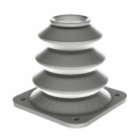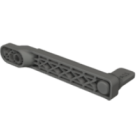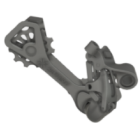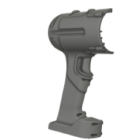Priming 3D prints
No matter how clean your print is, raw thermoplastic rarely looks “finished.” Layer lines, surface imperfections, and subtle texture shifts can undermine the final appearance — especially if you’re planning to paint. That’s where priming 3D prints comes in. Priming is more than just a preparatory step: it creates a uniform base, fills micro-defects, and improves paint adhesion, durability, and finish quality. For professional-grade results, it’s not optional — it’s essential.
Why is priming essential for 3D printed parts?
3D printing leaves behind traces of its process — visible striations, porous sections, and slight inconsistencies from layer to layer. A good primer levels those out. It also helps unify the surface color, ensuring that the final coat of paint doesn’t appear blotchy or uneven due to base color differences or translucent zones.
But priming isn’t just about cosmetics. Especially with FDM or resin prints, a primer acts as a bonding intermediary between the print material and subsequent coatings. This is crucial when painting difficult surfaces like PLA, ABS, PETG, or photopolymers — which often resist traditional paints or may react inconsistently without a compatible base.
Step-by-step guide to priming 3D prints
Successful priming starts with proper surface prep. Before applying any primer, your part should be:
- fully cured (if resin-printed),
- clean and free from oils, dust, or support residues,
- sanded as needed to remove support scars or rough zones,
- wiped down with isopropyl alcohol or a tack cloth.
Once prepared, apply the primer in thin, even coats. Always follow the manufacturer’s instructions regarding drying time between layers, and never rush to painting before the primer fully cures. Multiple coats may be needed for highly layered or porous prints — particularly with lower-resolution FDM parts.
After priming, lightly wet-sanding with fine-grit paper (e.g. 600–1000 grit) helps achieve a smooth, uniform surface that feels more injection-molded than printed.
Choosing the best primer for 3D printed surfaces
Not all primers are created equal, especially for 3D printed surfaces. When selecting the best primer for 3D prints, consider the following types:
- filler primers: thick-bodied, sandable primers that are ideal for FDM prints with visible layer lines; they build surface volume and help fill in small gaps or texture;
- spray primers (automotive-grade); popular for resin prints, these offer fine atomization, fast drying, and smooth coverage. Ideal for miniatures or detailed parts;
- adhesion-promoting primers: useful for materials like PP, PETG, or flexible filaments that resist bonding; these are often clear and provide a chemical bridge for paint;
- two-part epoxy primers: for industrial or high-stress applications, offering superior chemical resistance and bonding strength — especially useful on SLS parts.
Ultimately, the best primer depends on your material, part size, surface requirements, and final finish. Professional users often keep several types on hand for different projects.
Common priming mistakes and how to prevent them
Priming may seem straightforward, but there are a few mistakes that can ruin an otherwise great print:
- too thick, too fast: heavy coats cause runs, loss of detail, or uneven drying. Always apply multiple thin layers instead,
- incompatible products: not all primers work with all paints or plastics. Always test on a sample or low-importance part first,
- skipping prep: even the best primer won’t bond to greasy, dusty, or unsanded surfaces, rushing this step leads to peeling or bubbling later.
Consistency in technique matters just as much as product choice — patience and control always pay off.
Conclusion: why priming is key to a professional finish
Priming 3D prints is a crucial finishing step that transforms raw parts into smooth, paint-ready surfaces. Whether you’re creating functional prototypes, display models, or production-grade components, a properly applied primer improves both appearance and performance. The key is knowing your material, choosing the right product, and applying it with care. For anyone serious about professional-grade post-processing, mastering the primer stage is a non-negotiable skill.
Explore also
- Removing supports from 3D prints
- Sanding 3D prints
- Polish 3D printed
- Sandblasting 3D prints
- How to fill gaps in 3D prints
- How to paint 3D print
- How to foiling 3D prints
- How to metal plating 3D print
Related categories
 Austria
Austria  Bosnia and Herzegovina
Bosnia and Herzegovina  Bulgaria
Bulgaria  Croatia
Croatia  Czech Republic
Czech Republic  Denmark
Denmark  Estonia
Estonia  Finland
Finland  France
France  Germany
Germany  Greece
Greece  Hungary
Hungary  Ireland
Ireland  Italy
Italy  Latvia
Latvia  Lithuania
Lithuania  Poland
Poland  Portugal
Portugal  Romania
Romania  Slovakia
Slovakia  Slovenia
Slovenia  Spain
Spain  Sweden
Sweden  Switzerland
Switzerland  United Kingdom
United Kingdom  Ukraine
Ukraine  China
China  Hong Kong
Hong Kong  India
India  Israel
Israel  Japan
Japan  Malaysia
Malaysia  Philippines
Philippines  Saudi Arabia
Saudi Arabia  South Korea
South Korea  Taiwan
Taiwan  Thailand
Thailand  Turkey
Turkey  United Arab Emirates
United Arab Emirates  Egypt
Egypt  South Africa
South Africa  Tunisia
Tunisia  Canada
Canada  Mexico
Mexico  United States
United States  Brasil
Brasil  Colombia
Colombia  Australia
Australia  New Zealand
New Zealand 












